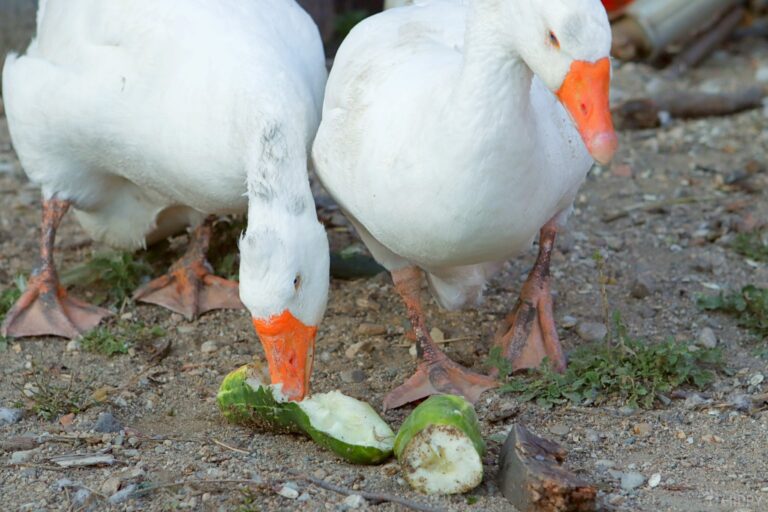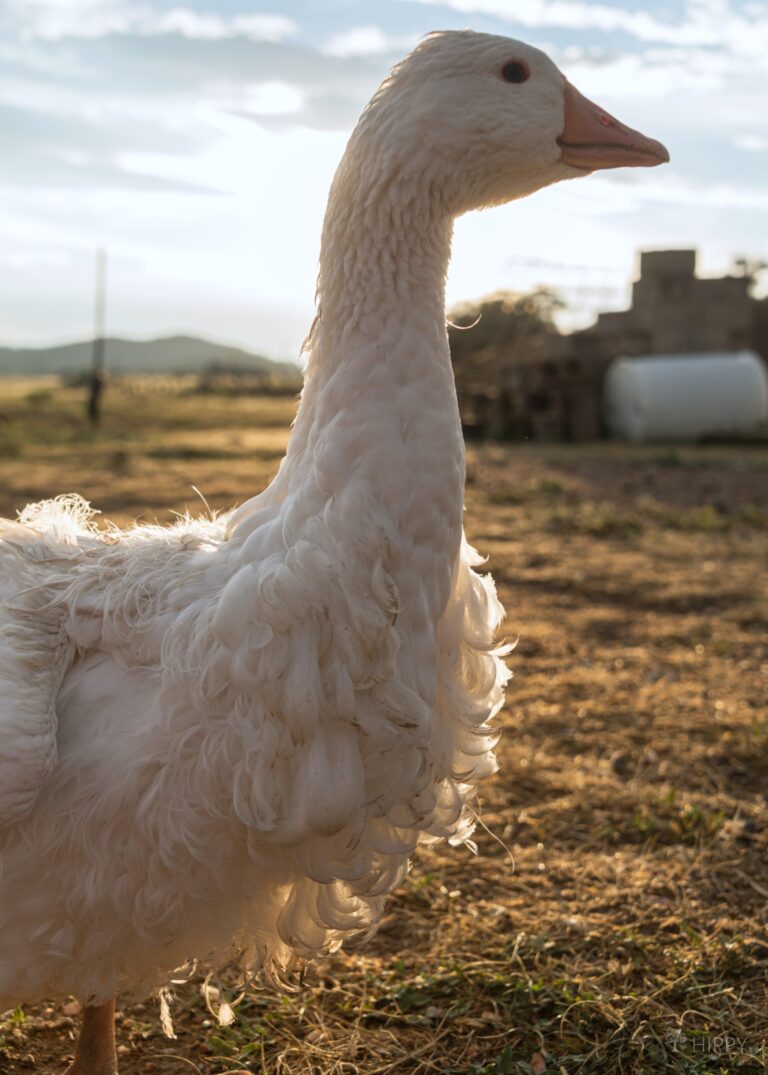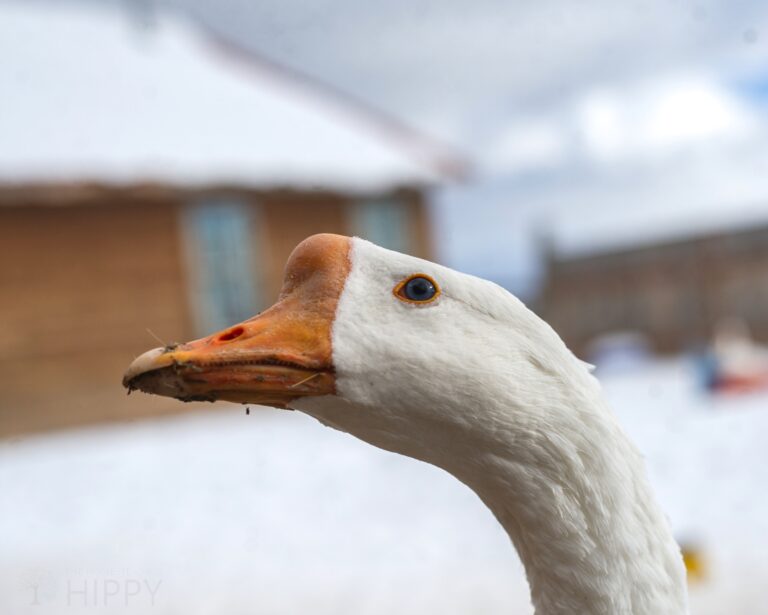Geese usually get a bad rap as birds that will poop all over your yard and gobble up your veggies out of your garden, but you might be surprised to learn they can be raised just like any other poultry.

In fact, geese are some of the oldest livestock birds around. They lay extra large eggs and produce lots of meat, especially compared to chickens. And, just like other birds, they come in every color of the rainbow or nearly so.
But some of the most popular, and most common, goose breeds happen to be white.
Whether you want a pure white goose that is as white as fresh snow, or a multicolored bird with dramatic accenting feathers, you’re bound to find the right one on the list below. Keep reading and we’ll get right to it.
Pure White Breeds
As mentioned above, there are many domestic breeds of geese that are completely white from bill to tail feathers. In fact, the only parts of them that won’t be white are their bills, eyes, and feet typically!
Czech
A domestic breed that’s raised for meat, the Czech is a goose with a lot of energy and personality.
They tend to be wonderful foragers and highly self-sufficient, and they also tend to really like people. This has given them a reputation as very friendly geese that are a lot of fun to watch and interact with. Many of their owners report forming close bonds with them over time…
The Czech is a pure white specimen, with brilliant, bright feathers all over, including on top and underneath.
It’s also worth noting that if you want eggs you probably want to look elsewhere, because even among geese, these aren’t the best layers: exemplary females will rarely lay more than 30 per year.
Slovak White
This Slovakian goose is an old and highly respected heritage breed of medium size, usually maxing out around 16 pounds (7.2 kilograms) with males being quite a bit larger than females.
This is a meat breed, raised both for the production of meat generally but also for their livers. In bygone eras, they were raised for both meat and down and mature feathers.
Today, though, they aren’t kept as utility geese: they’re extremely rare and only getting rarer, and well under a thousand are thought to exist in private hands.
The Slovak White is, as you’d expect, pure white but the exact tone of their feathers ranges from a brilliant white to a slightly off-white color. Their feathers are also rough and plush, giving them a somewhat frizzy look.
African White
A truly huge goose, you can tell the African White is a table bird just by looking at it! Large-statured with a broad breast, you can get a ton of delicious, high-quality meat from these geese.
They do lay eggs, but not many, and you’ll rarely see a female producing more than 30 or 35 every year. That being said, they have a reputation for being very healthy and hardy, and that’s a great way to keep costs down.
The African also comes in various colors, with the white being perhaps the most notable.
Like the Chinese White below, they also have a large and distinctive growth on their face starting at the base of their bill. It’s even suspected by some experts that the African is directly descended from the Chinese goose, whether deliberately bred or not.
West-of-England
An ancient heritage breed of uncertain provenance, ornithologists do know, though, that the West-of-England hails from England, and that is just about it.
They also know that they’re a very capable dual-use breed since they produce a good amount of fine meat and often plentiful eggs, with females laying between 45 and 50 yearly.
The plumage is nearly pure white, with males being a vivid, crisp white while females are somewhat dimmer with broken patches of gray or tan- and they have pink bills!
Of particular interest to some keepers is the fact that West-of-England geese are autosexing: males and females look completely different as chicks and maintain different coloration throughout life, making them easy to tell apart.
Sebastopol
Another heritage breed hailing from Europe, and another one that’s all white all over. The Sebastopol goose is traditionally raised for both meat and eggs, although females are not known to be particularly prolific layers.

One interesting fact about this distinguished breed is that the feathers are unique among most other geese because they have a curly structure that gives them a fringed appearance around their breast and neck.
Because of this peculiar feathering, they sometimes have a darker or tinted look since it diffuses light, but they really are pure white geese, I promise! And despite the historical utility nature of the Sebastopol, today they’re mostly kept as companions or show animals by fanciers.
Emden
Standing at an impressive 3 feet tall, the Emden is the largest and most majestic of the domestic geese breeds. These humongous birds tip the scales at a maximum of 30 pounds (13.6 kilograms), or even a little bit more.
As you would probably guess, this means they are a perfect goose for meat production, as slaughtering even a few can give you a freezer full of meat. They’re also raised occasionally for their feathers which are said to be sturdy and of high overall quality.
Emdens are pure, plain white all over, but you might see a faint dusting of gray or tan spots on the sides of their body, their breasts, and their belly.
Chinese White
Chinese geese come in many different colors, including a variety of earth tones and cream colors, but perhaps the most well-known and most popular is the Chinese White. They are so sparkling white they look almost bleached!

These are magnificent, large geese that are also notable for the large, bold orange growth on their foreheads. It definitely gives them a distinctive appearance that you won’t mistake for other geese!
When it comes to utility, the Chinese White is one of the very best to keep if you need lots of eggs. Highly productive females can lay around 80 yearly! No, that won’t compete with chickens and ducks but that is a heck of a lot of eggs for a goose.
Partially White Breeds
If you want a goose with a little more color, or one with a striking contrast, a partially white breed is probably right for you. The following breeds are sure to please…
Snow Goose
Snow geese are among the most beautiful and striking alive, with brilliant white feathers covering their bodies except for thin bands of jet black at the very ends of their wings, and on their tail feathers.
These are also some of the most common geese to be found in the world, and you’ve probably seen a huge flock of them migrating before.
If you’re a farmer, you are definitely familiar with them because they are a regular plague for crops, and migratory flocks can strip smaller parcels bare of vegetation in no time!
Ross’s Goose
The Ross’s Goose is another striking, beautiful, and wild specimen that is pure white all over except for small accenting black feathers on the tips of its wings and tail. Suffice it to say they are highly photogenic!
This is a wild species that’s commonly confused for the snow geese discussed elsewhere on this list.
But, if you live in North America chances are very good you’ve seen them before as they are quite common throughout Canada, much of the northern continental US, and even up into Alaska.
Danish Landrace
Often referred to simply as the Danish goose, and native to Denmark as the name suggests, this heritage domestic breed is firmly in the medium-size category and typically raised for meat, noteworthy for being extremely lean.
The only downside is that they reproduce and grow slowly, and females aren’t known for laying very many eggs per year. They were also historically important for producing feathers used to make quills.
However, they’re considered culturally significant to Denmark, and it’s easy to see why: These are incredibly beautiful geese, with pale orange feet and bills, and white feathers starting at the breast that shift towards a dusky tan or speckled light gray on the neck and tail.
The neck, head, face, and midsection are covered by dark gray-brown feathers.
Pomeranian
A willful, standoffish, and energetic breed, Pomeranians are renowned for their size and their bad attitudes.
They’re notorious for developing aggressive tendencies towards people, especially strangers, so get ready to spend a lot of time with them if you want them to be truly tame – and don’t trust them around kids or pets.
But, if you can put up with their quirks, you’ll find that Pomeranians can produce a lot of good meat and a modest amount of eggs, with females maxing out around 40 eggs, at most, yearly.
And these geese are definitely attractive, with beautiful dark gray or brown patches of feathers setting off their predominantly white plumage.
Roman Tufted
The Roman tufted is a dual-use breed that has the distinction of being one of the oldest geese known to have been kept in captivity.
Hailing from Italy, today the Roman Tufted is kept as a producer of both meat and eggs, and occasionally feathers, but there are also plenty of wild populations that have gone truly feral.
This is also a goose with a distinctively regal appearance as the name suggests, thanks to the large crown of feathers at the top of their heads.
The rest of the body shows various tones of tan and gray, but tends to be mostly white. Occasionally pure white specimens are found, though this is rare.
American Buff
One of the newer formalized US domestic breeds, the American Buff is another dual-use bird raised for eggs and meat.
Unfortunately, this isn’t a breed that really took off, if you’ll pardon the pun, because fewer and fewer of them are seen every year. It is suspected that they’re getting fairly close to extinction, despite the efforts of special interest breeders.
If you want to do your part in helping to maintain and resurrect this all-American breed, you’ll find that these large, friendly birds are quite beautiful, being mostly white along the lower breast and belly and covered on top with a huge variety of speckled colors. I hope they can last!
Tom has built and remodeled homes, generated his own electricity, grown his own food and more, all in quest of remaining as independent of society as possible. Now he shares his experiences and hard-earned lessons with readers around the country.
Find out more about the team here.
